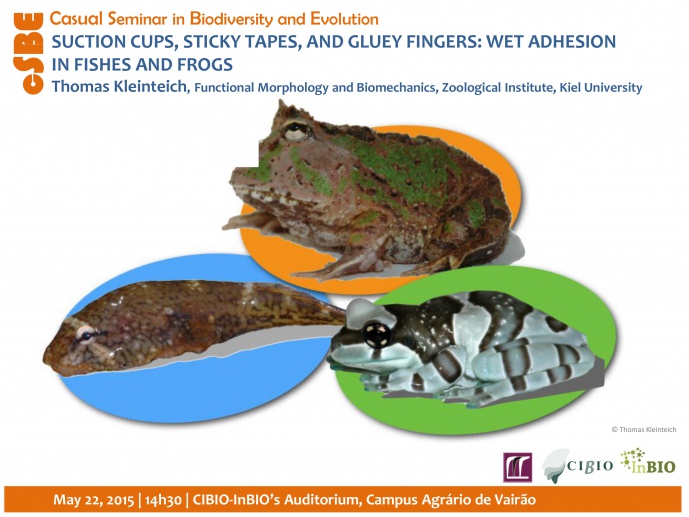SUCTION CUPS, STICKY TAPES, AND GLUEY FINGERS: WET ADHESION IN FISHES AND FROGS

CASUAL SEMINAR IN BIODIVERSITY AND EVOLUTION

Many organisms cling themselves to challenging substrates or are able to support their own body weight while moving upside down. These biological adhesive systems provide an enormous pool of solutions to common technical problems and even inspired the engineering of new biomimetic adhesive materials. However, while many organisms use liquid secretions for adhesion or are able to adhere under wet conditions (i.e. wet adhesion), most of the research on biological adhesive systems focused on dry adhesion in the past. Here I will present three very distinct examples for biological wet adhesive systems: (1) the suctorial disk of the Northern Clingfish Gobiesox maeandricus, (2) the tongue of the Chacoan Horned Frog Ceratophrys cranwelli, and (3) the toe pads of the Amazon Milk Frog Trachycephalus resinifictrix. The clingfish G. maeandricus shows outstanding suction adhesion on rough substrates on which engineered rubber suction cups always fail. The horned frog, C. cranwelli generates adhesion forces that are beyond its own body-weight with its tongue. The arboreal tree frog T. resinifictrix uses its adhesive toe pads during landing on narrow substrates such as branches of trees and withstands forces of up to 14 times its body weight during this process. Integration of anatomical data with experimental data on the performance of these animals allows me to conclude on the mechanism of adhesion in these wet adhesive systems. Each of these systems appears to be tuned by demands of performance on multiple levels from the entire animal to the presence of microscopic surface structures.
Thomas Kleinteich got his PhD in zoology in 2009 at the University of Hamburg, Germany on the evolution of intrauterine feeding in the Gymnophiona. Since then he has worked on the biomechanics of both vertebrates, particularly amphibians and fish, as well as arthropods. He has worked at UC Berkeley, UC Irvine, Friday Harbor labs, University of Washington and the Natural History Museum London. He now has a position at the Functional Morphology and Biomechanics department of the University of Kiel, Germany.
[Host: Arie van der Meijden, Applied Phylogenetics]
Image credits: Thomas Kleinteich